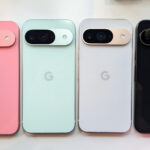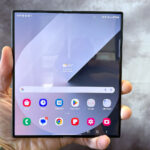The A-series Pixels have been very good over the past few years. And in the Pixel 9A, Google has taken a good midrange phone and made it great.
It’s $499, which feels just right for what you get in the 9A. Spend a bit more for the Pixel 9, and you’ll get some upgrades like a better ultrawide camera and more RAM, as well as little touches like Wi-Fi 7 rather than Wi-Fi 6E. But every time I wished for something on the 9A that it doesn’t offer, I kept coming back to that price. At $499, it’s easier to let go of some things than it was with, oh, the $599 iPhone 16E.
$499
The Good
- Robust IP68 rating
- Seven years of software updates
- Brighter, bigger screen
The Bad
- Missing a couple of AI features
- AI is occasionally handy, usually weird
More than just a list of specs, the Pixel 9A behaves like a device in a mature product line. When I transfer a Pixel Watch 2 from another Pixel phone to this one, it just works. When I use fast pair to connect some OnePlus earbuds I used with another Android phone, it just works. That hasn’t always been the case with the Google phones I’ve tested, but the company has done a much better job of connecting the dots in its ecosystem for this generation of Pixels. And for $499? That’s a real sweet deal.
Hardware, screen and battery life
Last year, when I reviewed the Pixel 8A at home in Seattle, I thought the screen was just fine, but my colleague Vjeran Pavic took the phone on a trip home to Croatia and declared it too dim. Fair point; Seattle’s gray skies aren’t much of a stress test for screen brightness. So I paid extra attention to the 9A’s display, especially since Google claims it’s 35 percent brighter than the previous one. It handled some rare sunny days in March well, and it might even be acceptably bright to someone who lives in a sunnier place than I do. It’s also bigger, at 6.3 inches compared to 6.1 inches, even though the phone is only slightly larger than the 8A, which is a nice bonus.
The 9A gets another kind of upgrade in the form of an IP68 rating, which means it’s dustproof and resistant to water immersion. The IP67-rated 8A was water submersible, too, but the 9A can survive in deeper water for up to half an hour. There’s wireless charging, which is appreciated even if it’s just up to 7.5W. And the 9A breaks from the rest of the Pixel series by setting the cameras flush with the phone’s back panel, rather than on a raised bar. It’s a distinct look, and I don’t hate it, but the most striking thing about my review unit is the vibrant pink “peony” color. This phone isn’t the standard black rectangle, and I appreciate that.
The 9A has the biggest battery in the Pixel series with a 5,100mAh cell, and Google claims it has the best battery life of any Pixel when you use extreme battery saver mode. Battery life is good, if not outstanding. A moderate day, mostly spent on cellular data with a healthy dose of streaming video and four hours of screen time, brought the battery down around 50 percent by the end of the day. I tested the phone with the always-on display enabled full time, screen refresh rate at its highest setting, and used light mode rather than dark mode. All those battery-draining settings make the Pixel 9A’s battery a lot more average.
Like the rest of the Pixel 9 series, the 9A uses Google’s fourth-gen custom Tensor G4 chipset. It’s paired with 8GB of RAM, and it feels snappy. It handled Diablo Immortal without a problem, as our deputy editor Todd Haselton observed. When you remember that this is a $500 phone — with seven years of software updates at that — it’s pretty impressive.
Pixel phones have really hit their stride recently
I feel like Pixel phones have hit their stride recently. Small tweaks over the past couple of generations have added up to a big difference in day-to-day use. When I’m scrambling to log into the Starbucks app while I’m sitting in the drive-through, I can use face recognition to authenticate and autofill my credentials with my password manager rather than scanning my fingerprint. I can tap on a prompt to pair a previously saved set of earbuds and be confident that the process will work without manually connecting them. These small moments add up to a better experience.
There’s plenty of AI here, too. There’s the face-swapping Best Take and Add Me camera features, which come in handy every once in a while. I used Gemini Live for a somewhat helpful, if a bit awkward, brainstorming session. Related: if you know how to get a three-year-old to use the bathroom at preschool, let me know. But the 9A is missing some AI features on the other Pixel 9 phones, like the Screenshots app and call notes, which I was bummed about. It runs a smaller version of Google’s on-device AI than the other Pixel 9 phones.
The Pixel 9A has good cameras for a $500 phone. There’s a 48-megapixel main camera with stabilization, a 13-megapixel ultrawide camera, and a decent 13-megapixel selfie camera. Not bad, considering Apple only gives you one rear camera on the $599 16E.
But the 9A uses a smaller 1/2-inch sensor than the one used by the other Pixel 9 phones. You’ll hit its limitations in low light, where pricier peers retain more fine detail. Portrait mode isn’t too impressive either — there’s a smeary look where parts of the subject should be gradually falling out of focus.
The 9A produced some of the most intensely flat and over-processed photos of high-contrast scenes — the kind you associate with bad HDR — that I’ve seen from a smartphone camera in a while. It’s not every time, and they don’t look quite as bad on the phone screen, where the highlights are brighter thanks to Ultra HDR, but when you export them off your device, you lose that information in a lot of cases. If you’re picky about your photo quality, this is one area where it makes sense to step up to a pricier device.
At its best, the Pixel 9A feels like an absolute steal. At its worst, it feels like, well, a $500 phone. Maybe the distance between $499 and $799 — the Pixel 9’s going rate — isn’t much if you’re paying for it in installments, but it’s a sizable difference if you’re paying out of pocket.
The best endorsement for the Pixel 9A is that there’s a lot you just won’t notice as you use this phone. You won’t notice performance or battery life, because they’re fine. They’re not outstanding, but they’re not noticeably bad. You don’t notice how seamless it is to use face recognition to open your password manager and log into your bank app. On a phone that costs half the going rate of a top-tier flagship, that’s pretty damn good. And that peony pink doesn’t hurt either.
Photography by Allison Johnson / The Verge
Agree to Continue: Google Pixel 9, 9 Pro, 9 Pro XL, 9 Pro Fold, and 9A
Every smart device now requires you to agree to a series of terms and conditions before you can use it — contracts that no one actually reads. It’s impossible for us to read and analyze every single one of these agreements. But we started counting exactly how many times you have to hit “agree” to use devices when we review them since these are agreements most people don’t read and definitely can’t negotiate.
To use a Pixel 9 series phone, you must agree to:
The following agreements are optional:
- Provide anonymous location data for Google’s services
- “Allow apps and services to scan for Wi-Fi networks and nearby devices at any time, even when Wi-Fi or Bluetooth is off.”
- Send usage and diagnostic data to Google
- Talk to Google hands-free: “If you agree, Google Assistant will wait in standby mode to detect ‘Hey Google’ and certain quick phrases.”
- Allow Assistant on lock screen
Additionally, if you want to use Google Assistant, you must agree to let Google collect app info and contact info from your devices. Other features like Google Wallet may require additional agreements.
Final tally: five mandatory agreements and at least five optional agreements
Read the full article here














